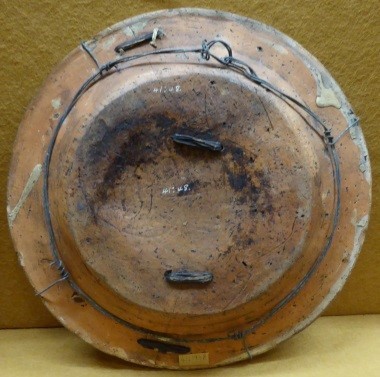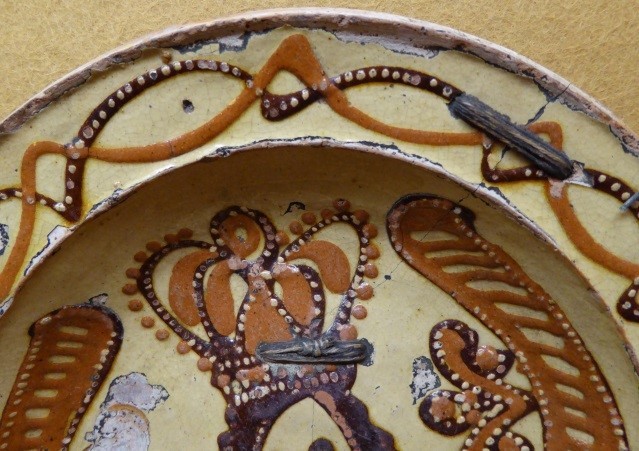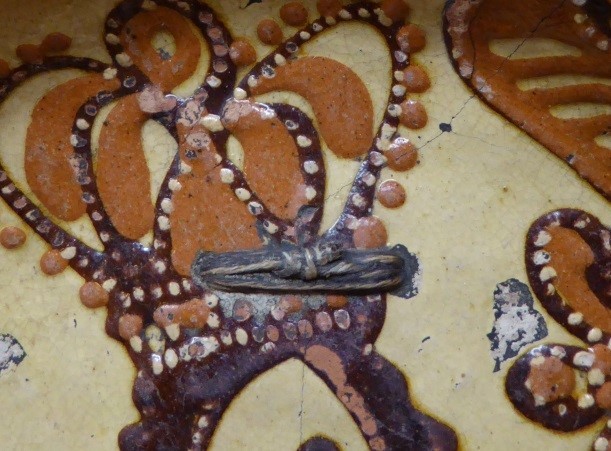In this blog, our Collections Registrar Pam Keeton gives a detailed examination and fascinating insight into her favourite object in our collection, a 17th century repaired plate.


Object number 41:1948
H 3.5cm x 24.5cm diameter
On display at Cliffe Castle Museum, Keighley.
Donated to Bradford Museums & Galleries in 1948.
This earthenware, lead glazed plate, vigorously decorated with the slip trailed image of King Charles II is one of my favourite objects. Its quirky, unique style never fails to catch my attention and charms me for a number of reasons….
There is nothing extraordinary about the earthenware plate by way of its size, material or construction. In fact it’s very ordinary, functional even. It’s the lively, exuberant ornamentation, the expression of the potters hand and the historic conservation which both amuses and fascinates me.
The decoration on the plate was created to celebrate the Coronation of Charles II and the Restoration of the monarchy in May 1661 after a decade of puritanical rule under Oliver Cromwell. Craftsmen, including the Staffordshire potters, reacted keenly to the resurgence in Royalist support and dishes and plates of this type would have been acquired by, or presented to, an individual with firm royalist and political affiliations. In fact a public holiday was declared on the 29 May 1661 and was known as Oak Apple Day after the tale about Charles escaping the Roundhead army by hiding in an oak tree. It was a day given over to all sorts of fun and merriment including being thrashed with nettles if you weren’t wearing a sprig of oak!
English decorative slip trailed ceramics were popular in the late 17th century and early 18th century and were produced mainly in Staffordshire. In the past it’s been viewed as a crude, rather unskilled and unselfconscious type of material culture, but now many view it with more respect: its workshop production involved distinct skills and processes which had to be mastered and the ‘naïve’ decorative style was quite deliberate, designed to appeal to the popular demand for decorative wares.
This particular style of slipware ceramic is often referred to as Toft-ware after the leading maker Thomas Toft (d.1689) but of whom little is known. The wares were elaborately decorated plates, dishes and chargers with the popular designs being of mermaids, unicorns, coat of arms, commemorative themes and notable figures of the day such as King Charles II and his wife Queen Catherine of Braganza. The rims frequently have the distinctive cross-hatch/lattice or interlacing line borders and sometimes carry the name of the potter. As well as the extended Toft family of Thomas, Ralph, Cornelius and James, other names associated with this style are William and George Talor, Ralph Simpson and Ralph Turner. Although there are relatively few examples of this work in existence, it can be seen represented in many major museum collections.
This plate has no makers mark and has not been attributed to a particular maker. It may have been made by an undocumented potter but it has similarities to the work produced by George and William Talor.
The decoration on this object may appear rustic but it’s far from clumsy – slip trailing requires great skill and dexterity from a well-practiced craftsman and no two pieces will ever be identical. The challenges that the slip-trail technique represent inspires me. The design was created by first coating the earthenware clay plate in a white pipe clay slip, then ornamented with trailed on slip in contrasting light and dark red earth colours, dotted with white and finished with a lead glaze that turns the white base layer a soft cream or ochre colour. There is no margin for error and any mistake has to be incorporated or the whole thing removed and started again.
‘Slip’ is the term used to describe liquid clay with a creamy consistency and the tone of the colours comes from the naturally occurring iron and mineral content of the clay. Traditionally it was applied from the tip of a horn or from a ‘slip cup’ that used a feather quill or hollow reed as a spout to deliver the slip onto the surface. The working time is very short and the slip must be kept moving constantly to keep it in suspension. The liquid clay stiffens as soon as it meets the dry surface and it’s this action that forms the raised lines similar to piped icing. Unfortunately, if the slip layers do not bond well enough to the body of the ceramic or if the object leads a particularly busy life, the surface is easily chipped and damaged.
Slip clay has a long history of being used to decorate pottery and tiles, in fact 5000 year old sherds of slipware have been found throughout Asia and Europe. As well as figurative designs it can be used to create marbling, feathering and scraffito where one layer is scratched through to another colour below. All of these techniques are still practiced by potters today and in the late 20th century studio potters Bernard Leach and Paul Spence paid direct homage to Toft-ware with their own versions.
There is another unique feature about this object that fascinates me as a conservator. It has been broken in half and repaired – not recently and not in a manner we would recognise today. The body of the ceramic has had holes pierced either side of the break and the plate has been literally stitched together with twine.


Historic repair methods to ceramics before the use of modern adhesives are well documented. ‘Sewing’ or ‘lacing’ pieces together with thread, twine or wire was common in the 17th and 18th centuries, as indeed in ancient history, but didn’t necessarily provide longevity. Thread can rot and fray and wire can corrode and chaff the body of the ceramic. The more common and widely practiced method of bringing broken edges together was by riveting with metal staples. This, like slip trailing is difficult to do well and requires great hand-skills and dexterity.
The broken object was first bound so that all of the edges were aligned and then a bow drill used to pierce holes either side of the break. For a successful repair, careful consideration has to be given to the position of the holes so that the rivets give maximum strength but don’t inadvertently spoil decoration (rarely entirely successful!). The holes were typically drilled at about 15-20° to the fracture so that the pressure from the rivet would pull the edges together. Some rivets are U shaped and can only be seen from one side, or they go all the way through and join at the other side. The metal rivets were made out of short pieces of iron, brass, pewter or silver rod. Each rivet was heated up, fed into the holes and tightened up the joint as it cooled. The cavities were then further strengthened by filling them with a gluey mixture or fine cement. Silver was the most expensive and ideal for white bodied wares whereas brass and iron were better for heavier and more utilitarian pieces. Their down side is that over time they corrode which can stain the pottery and cause the repair to fail.
In Europe, pot and China riveting was a well-known occupation as decorative ceramics were valuable, highly prized. There are bills of sale (1 shilling for 2 rivets but 2 shillings per rivet in silver in 1770) and trade cards in archives as well as being described in trade encyclopaedias and engravings. Similarly, the Japanese have a repair style known as Kintsugi or ‘golden joinery’ where the broken sherds are mended with sticky lacquer which is dusted or mixed with powdered gold. There is no attempt to disguise the repair because it’s accepted as part of the objects history and life – a well-balanced and graceful philosophy I feel.
Back to this particular ill-fated plate, that it was repaired and continued to survive for so many years until it was donated to the museum in 1948 says a lot in itself. We don’t know when it was broken, how it was broken, who broke it (and the consequences…), who repaired it and at what cost. Was it a relatively contemporary repair soon after it was made? By the potter themselves? Or later? But how much later? Why it got repaired speaks for itself: it has clearly always been a loved and highly prized belonging. It was considered worth the time and expense of being mended and this is a very neat, competent repair that hasn’t failed and has stood the test of time.